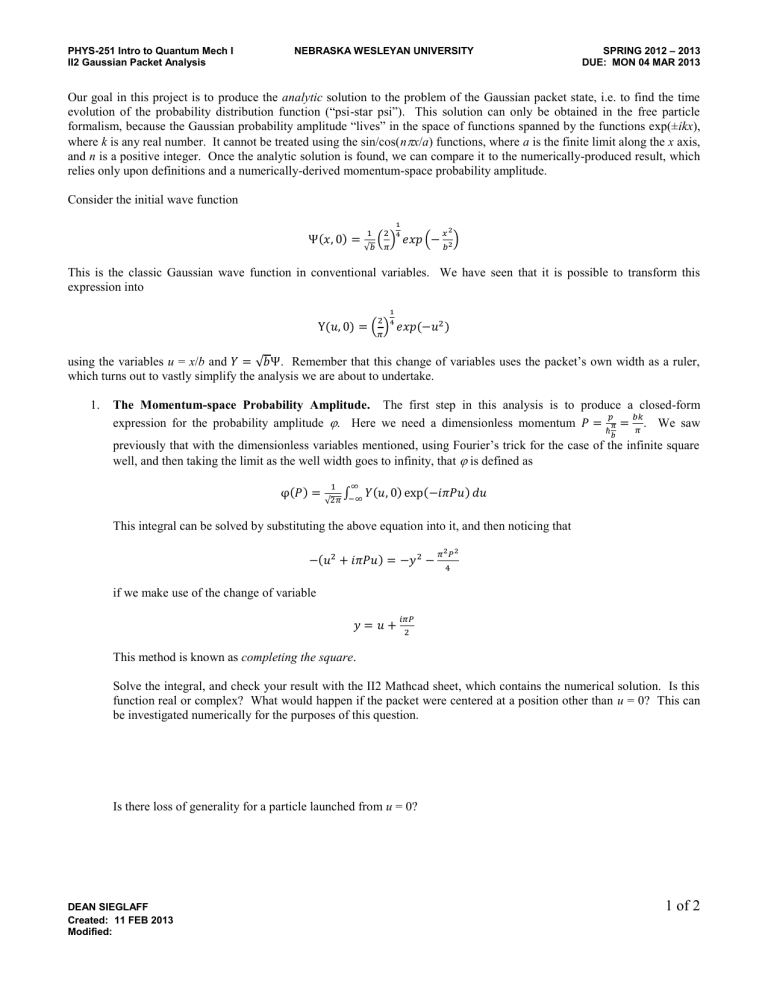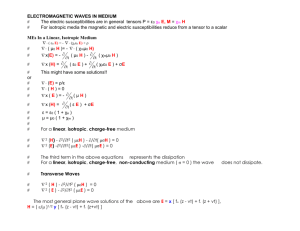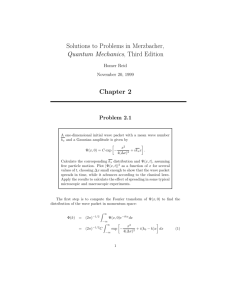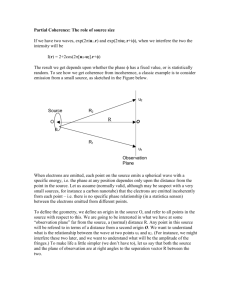Gaussian Packet Analysis - Nebraska Wesleyan University

PHYS-251 Intro to Quantum Mech I
II2 Gaussian Packet Analysis
NEBRASKA WESLEYAN UNIVERSITY SPRING 2012 – 2013
DUE: MON 04 MAR 2013
Our goal in this project is to produce the analytic solution to the problem of the Gaussian packet state, i.e. to find the time evolution of the probability distribution function (“psi-star psi”). This solution can only be obtained in the free particle formalism, because the Gaussian probability amplitude “lives” in the space of functions spanned by the functions exp(± ikx ), where k is any real number. It cannot be treated using the sin/cos( n
x / a ) functions, where a is the finite limit along the x axis, and n is a positive integer. Once the analytic solution is found, we can compare it to the numerically-produced result, which relies only upon definitions and a numerically-derived momentum-space probability amplitude.
Consider the initial wave function
Ψ(𝑥, 0) =
1
√𝑏
(
1
2 𝜋
)
4 𝑒𝑥𝑝 (− 𝑥
2 𝑏
2
)
This is the classic Gaussian wave function in conventional variables. We have seen that it is possible to transform this expression into
1
Y(𝑢, 0) = (
2 𝜋
)
4 𝑒𝑥𝑝(−𝑢 2 ) using the variables u = x / b and 𝑌 = √𝑏Ψ . Remember that this change of variables uses the packet’s own width as a ruler, which turns out to vastly simplify the analysis we are about to undertake.
1.
The Momentum-space Probability Amplitude.
The first step in this analysis is to produce a closed-form expression for the probability amplitude
. Here we need a dimensionless momentum 𝑃 = 𝑝 ℏ 𝜋 𝑏
= 𝑏𝑘 𝜋
. We saw previously that with the dimensionless variables mentioned, using Fourier’s trick for the case of the infinite square well, and then taking the limit as the well width goes to infinity, that
is defined as
φ(𝑃) =
1
√2𝜋
∫
∞
−∞
𝑌(𝑢, 0) exp(−𝑖𝜋𝑃𝑢) 𝑑𝑢
This integral can be solved by substituting the above equation into it, and then noticing that
−(𝑢 2 + 𝑖𝜋𝑃𝑢) = −𝑦 2 − 𝜋
2
𝑃
2
4 if we make use of the change of variable
This method is known as completing the square . 𝑦 = 𝑢 + 𝑖𝜋𝑃
2
Solve the integral, and check your result with the II2 Mathcad sheet, which contains the numerical solution. Is this function real or complex? What would happen if the packet were centered at a position other than u = 0? This can be investigated numerically for the purposes of this question.
Is there loss of generality for a particle launched from u = 0?
DEAN SIEGLAFF
Created: 11 FEB 2013
Modified:
1 of 2
PHYS-251 Intro to Quantum Mech I NEBRASKA WESLEYAN UNIVERSITY SPRING 2010 – 2011
What is the form of the
function?
2.
The Probability Amplitude as a Function of Time.
The next step is to plug the above result into the formula for the expansion definition of the wave function, along with the separation of variables method. For this, we need a non-dimensional time. The choice for this comes fairly straightforwardly from the expression for the general time factor in the separation of variables method: exp (−𝑖
𝐸 ℏ 𝑝
2 𝑡) = exp (−𝑖
2𝑚ℏ 𝑡) = exp (−𝑖 ℏ𝑘
2
2𝑚 𝑡) = exp (−𝑖 ℏ 𝜋2𝑃2 𝑏2
2𝑚 𝑡) = exp (−𝑖 𝜋
2
𝑃
2
4
2ℏ
( 𝑚𝑏
2 𝑡))
In the last step, the particular coefficient on t comes naturally from the outcome of part 1, in which the factor of ¼
2ℏ arises. So the non-dimensional time 𝜏 = 𝑚𝑏
2 𝑡 , and so we have for the wave function
𝑌(𝑢, 𝜏) = √ 𝜋
2
∫
∞
−∞ 𝜑(𝑃) exp(𝑖𝜋𝑃𝑢) exp(−𝑖 𝜋
2
𝑃
2 𝜏) 𝑑𝑃
4
Once again, this can be handled by completing the square. If 𝐴 =
1
4
(1 + 𝑖𝜏) and 𝐵 = 𝑖𝑢 then
𝐴𝜋 2 𝑃 2 − 𝐵𝜋𝑃 = 𝑦 2 −
𝐵 2
4𝐴 only if 𝑦 = √𝐴 (𝜋𝑃 −
𝐵
2𝐴
)
Determine the time evolution of the wave function. Be sure that your expression agrees with the initial state!
3.
The Probability Distribution Function.
Prepare the Y * Y function. You should get a relatively simple function of space and time. Check your result against the numerical version.
4.
Launching With Initial Momentum. This is a very interesting question: How do you modify what you have in order to launch with an initial non-dimensional momentum P
0
? Do not reanalyze the whole problem!
Rather, consider that the particle will be moving with constant velocity. How do you modify the position coordinate u so that it becomes u – v group
where v group
is the group velocity of the packet? In normal units we’d call that p / m .
Check it with the numerical machinery.
DEAN SIEGLAFF
2 of 2











